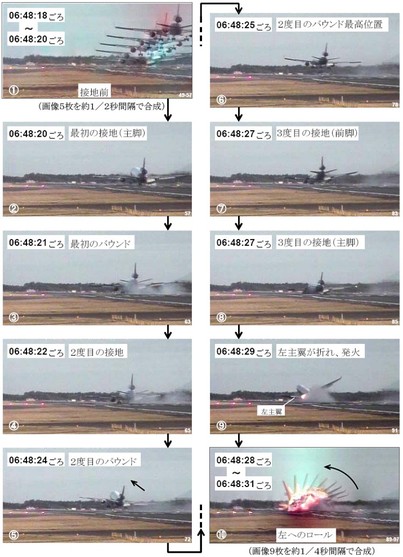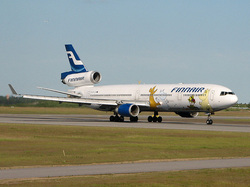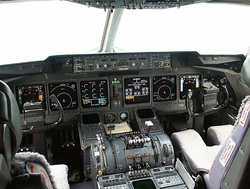
In this accident, when the airplane landed on Runway 34L at Narita International Airport, it fell into porpoising. It is highly probable that the left wing fractured as the load transferred from the left MLG to the left wing structure on the third touchdown surpassed the design limit (ultimate load).
It is highly probable that a fire broke out as the fuel spillage from the left wing caught fire, and the airplane swerved left off the runway rolling to the left and came to rest inverted on the grass area.
The direct causes which the airplane fell into the porpoise phenomenon are as follows:
a. Large nose-down elevator input at the first touchdown resulted in a rapid nose–down motion during the first bounce, followed by the second touchdown on the NLG with negative pitch attitude. Then the pitch angle rapidly increased by the ground reaction force, causing the larger second bounce, and
b. The PF‘s large elevator input in an attempt to control the airplane without thrust during the second bounce.
In addition, the indirect causes are as follows:
a. Fluctuating airspeed, pitch attitude due to gusty wind resulted in an approach with a large sink rate,
b. Late flare with large nose-up elevator input resulted in the first bounce and
c. Large pitch attitude change during the bounce possibly made it difficult for the crewmembers to judge airplane pitch attitude and airplane height relative to the ground (MLG height above the runway).
d. The PM‘s advice, override and takeover were not conducted adequately.
It is somewhat likely that, if the fuse pin in the MLG support structure had failed and the MLG had been separated in the overload condition in which the vertical load is the primary component, the damage to the fuel tanks would have been reduced to prevent the fire from developing rapidly.
It is probable that the fuse pin did not fail because the failure mode was not assumed under an overload condition in which the vertical load is the primary component due to the interpretation of the requirement at the time of type certification for the MD-11 series airplanes.
The JTSB analyed that the first officer was pilot flying, in response to the wind report while on approach to Narita the first officer probably set Vapp to be Vref+10=164 knots. Descending through 1000 feet AGL the autopilot and autothrottle was still engaged, the captain, pilot monitoring, commented: "Yee haw ride' em cowboy." Descending through 500 feet the calibrated airspeed was oscillating between 152 and 180 knots as result of turbulent conditions and slow response by autothrottle, the speed deviations exceeded the criteria of a stabilized approach. The captain reminded the first officer "stabilize!" but did not demand a go around permitting the first officer to continue the approach.
At 198 feet AGL the autopilot was disconnected with autothrottle remaining engaged, at that point the aircraft was showing an 178.5 KCAS (Vapp+14.5 knots), the aircraft was almost (+0.19 dots off) on glide path profile. When the aircraft descended through 92 feet AGL the aircraft had slowed to 154 KCAS (Vapp-10 knots) and had descended below the glide path (-0.54 dots off) with the EPR near idle thrust, the JTSB stated: "It is highly probable that this large speed decrease stemmed from the inability of the autothrottle system to counteract the large wind velocity change (decreasing head wind component) during the descent as described in 2.14.1, and the fact that the thrust was kept at idle during the increment of the pitch angle to 3.5º. The increased pitch angle and corresponding column input indicates the PF‘s intention to correct the lowered flight path." There had been no calls from the pilot monitoring recorded on the cockpit voice recorder, the JTSB stated: "The PM should have made advice to the PF about the airplane attitude and called out the deviation from the glide slope and the CAS. Further, overriding or taking over the control of the airplane to execute a go-around was one of the options for the PM as he was the PIC."
When the aircraft descended through 50 feet AGL the rate of descent was 13 fps (780 fps) at a pitch attitude of +1.1 degrees, in the previous 60 landings a pitch attitude of 2-3 degrees and a rate of descent between 5 and 10 fps (300-600 fpm) had been used. The autothrottle started to retard the thrust levers reaching idle at 20 feet AGL. The JTSB stated: "It is probable that, taking into account the strong head wind, the large sink rate and the deepened flight path, the PF should have delayed the timing to retard the thrust levers or should have slowly retard the lever to delay to be idle, by way of overriding autothrottle. It is highly probable that the PF did not control the thrust actively and properly by overriding the autothrottle."
The first officer started the flare at about 20 feet (usually at 30 feet) maintaining an attitude of +1.1 degrees until that point, then rapid and large elevator inputs suggest the first officer recognized the late flare, the pitch angle increased to +4.6 degrees in the last 2 seconds before touchdown. The JTSB stated: "As described in 2.14.10.1, if an appropriate flare had been initiated at 30 ft RA as stipulated in the manual, two large bounces which triggered this accident could have been avoided."
Just before first touchdown a nose down input was recorded but could not be conclusively explained by the investigation with possilities of the first officer becoming concerned about a possible tail strike, excessive concerns of a nose up movement with the spoilers extending or the first officer hoping to put the nose gear down as soon as possible due to the strong winds. The elevator position changed to 4.9 degrees nose down just prior to touchdown at 7 fps (420 fpm) and at +1.63G, the aircraft bounced.
Another forward pressure on the elevator reduced the elevator position to 6.7 degrees nose down 1 second after touchdown, the aircraft nose dropped from 4.6 degrees nose up at touch down to below zero 1.5 seconds after first touchdown, the main gear was airborne again followed by the nose gear.
The aircraft touched down a second time on its nose gear first followed by the main landing gear resulting in a quick nose up movement and the aircraft bounced a second time reaching 16 feet AGL.
The JTSB stated looking at the immediate aftermath of second touch down: "When the NLG rebounded off the runway and the nose moved upward, the PM, with calm monitoring of airplane behavior as PM and PIC, he could have chosen bounce recovery or go-around, taken over the PF without delay, done either operation. This was possibly the last opportunity to avoid the accident."
Following the quick nose up movement a large nose down input by the first officer (elevator position about -7.7 degrees) occurred, the attitude reached +6.7 degrees nose up before quickly reducing again. When the pitch went through 0, the first officer began to provide nose up inputs (elevator position about +0.9 to +1.6 degrees) which slowed but did not stop the nose down movement, the aircraft reached -4.9 degrees of pitch attitude and touched down a third time at 21.5 fps rate of descent (1290 fpm) resulting in a recorded vertical acceleration of +3.06G, the left wing attachment point to the fuselage fractured, the aircraft pitched up to +8 degrees with the right hand wing generating high lift rolling the aircraft to the left. No action by the captain could have prevented the outcome at this stage.
The JTSB analysed that during third touchdown a load of 887,000 lbs had been transferred from the left main gear to the left wing which exceeded the design and certification specifications of the aircraft resulting in the fracture of the wing structure. The failure mode of the wing was similiar to the Newark accident (Fedex Flight 14, MD11 N611FE on July 31st 1997).
You can find more information on avherald.com


